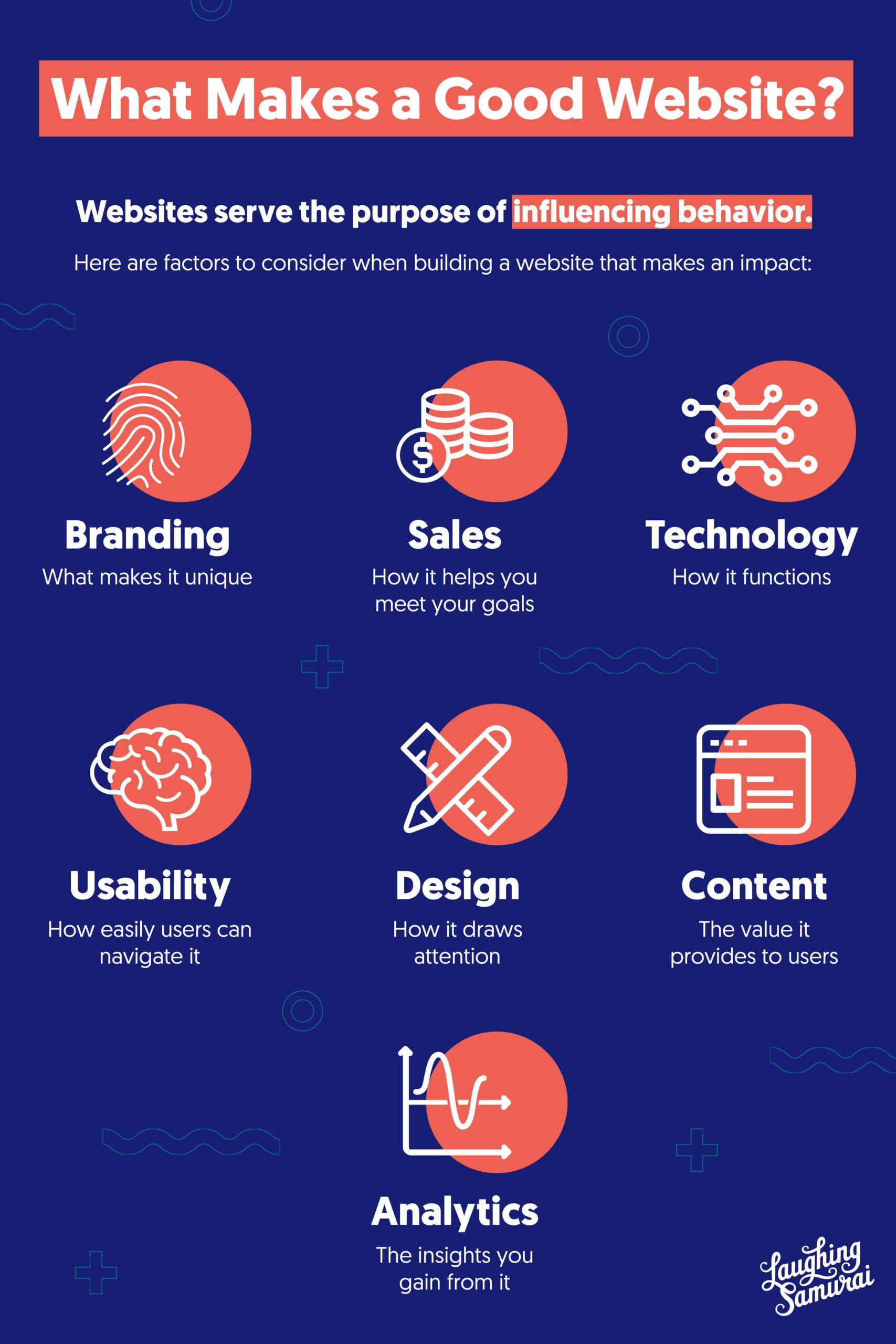With so many crappy websites out there, sometimes it can be hard to spot a good one. They exist, though, and I would venture to say that there are more good ones than bad. A lot of times, what makes them good isn’t easily spotted by the naked eye or your browser (unless you know some tricks).
The truth is that even the simplest site is a complex system that combines elements of branding, sales, technology, psychology, design, content and data science. A system where all these moving parts work together to do one thing: influence behavior. From purchasing a product to learning something new or filling out a contact form – these are but a few of the behavioral objectives one keeps in mind when building a website. Or, at least, they should.
If you’re not thinking about the end goal, then you’ve got some ‘splainin’ to do.
After all, it’s only once you’ve decided on the goals you want your website to achieve that you can start building one that meets them. It’s what will help dictate your choices for each element within the complex system. And if even a single element is out of line, doesn’t stick to your purpose or is done halfheartedly, your website will suffer.
Behavior can’t stand alone, but it’s a damn good place to start.

Good Websites Are Consistently Branded
Branding is the glue that holds everything together. It’s what shows people who you are, and it’s what they’ll remember about you. In other words, branding is how you connect with your audience, build rapport and stimulate a desire for your product or service. Spending time defining what YOU mean to YOU can make it easier to connect with consumers that share the same values and goals as your brand.
For your website, strong branding is important because it informs how you speak to your user, what you look like and what you stand for. A consistent brand that captures your audience’s attention will help you stand out among the noise and keep you memorable. If a user recalls your brand positively and in the way you designed, you’ve made a successful impression.
We bring up branding first because you’ll need to define your brand before designing a single web page. It needs to be present from the beginning in order to create a cohesive and authentic user experience.
Good Websites Know What They’re Selling
Every good website is selling something, whether you realize it or not. Now, don’t think of sales as the used car salesman that follows you around asking if you want free popcorn. Neither is it the annoying store salesman who follows you around “adjusting” products on a shelf. Every good website sells because if it didn’t, then you wouldn’t stay on it for more than a few seconds.
Sales tactics and techniques are at the core of why you stay on a website long enough to read what they’re saying and, possibly, take action. A headline gets you to read the rest of the page. A call to action gets you to… ACT! Understanding these techniques will help you achieve goals with your website and give you tangible results to show.
Your goals may not always take the form of a concrete action like buying a product or filling out a form. Interactions and time spent on a website are also goals with valuable outcomes.
Good Websites Leverage Technology
Think of technology as the vehicle you choose when embarking on a journey. My family and I recently took a road trip to the Blue Ridge area of Georgia, and we had the good sense to rent an oversized SUV. Although we have a small crossover, we knew that it wouldn’t be enough for the amount of driving we had to do or the amount of stuff you need to pack when traveling with a baby. And we’re glad we did it as the trip was a lot more enjoyable because of it.
The right framework for your website is extremely important and can make or break what could have been a good website. Technologies to consider when building your website include the content management system (CMS), development framework, server environment, analytics tools and the plugins and extensions that drive your functionality, goals and objectives.
You also want to make sure that your website’s code is clean, well-structured, updated and properly set up to avoid alien attacks and malicious intrusions. Clean code not only helps with website security but also makes your site faster. Search engines love fast sites, and site speed can dramatically improve or diminish your search engine ranking, and as a result, your overall performance.
Good Websites Understand Usability
There’s a lot of buzz around User Experience (UX) and User Interface (UI) design these days and for good reason. The terms warrant their own collection of in-depth blog posts, but in a nutshell, they are design standards based on expected human behaviors with an understanding of the psychology of the user while interacting with your website.
UX/UI is the reason why navigation bars are normally located at the top of websites, why your power button on your TV remote is always at the top left of the remote, and why the power switch on your coffee maker has a little light that lets you know it’s on.
UX/UI is in more places than you know, even if you aren’t always aware of it. This imperceptibility is a sign of good UX and UI design.
Since user interactions are at the core of web design, good UX and UI ensure that things are what they are supposed to be, functioning as they should be and in the places they ought to be. Coupled with an understanding of how a user scans a page, they’re powerful tools for getting users to interact with the elements on your website and take the actions you laid out for them – oftentimes without realizing it was deliberate on your end.
Good Websites Don’t Skimp on Design
Web design is more than just colors, fonts and pretty pictures. Of course, colors, fonts and pretty pictures do make a huge impact, but it goes much deeper. Things like photography, typography, balance, flow, color theory, psychology and tone all contribute to what good website design ought to be.
Good web design takes into consideration the sensibilities and behaviors of the viewer. I’ll say that again… Good web design takes into consideration the sensibilities and behaviors of the viewer. Good web design is not about what the designer likes, nor is it about what the client likes. It should always be about the end-user. If it isn’t, then it’s underserving those who will be interacting with the website.
Yes, I get that sometimes the client is also the customer, and that’s okay. What I’m talking about is designing something that the user will enjoy using, even if you don’t agree with it, because at the end of the day, it’s the user who matters in that context.
Good Websites Care About Content
They don’t say content is king for nothin’! Your website content plays an essential role in boosting search engine traffic, capturing user attention, building an audience, encouraging lengthier visits and successfully guiding action.
It’s important that you don’t mistake the gravity of content, though, for it being more important than the other elements listed. In truth, developing great content relies heavily on an understanding of psychology and communication. It also has to fit in with web design. If it doesn’t incorporate these facets, it loses all effectiveness.
And no, content isn’t just blog posting. It’s all of the text on your website from FAQs to headlines, as well as visually stimulating content like photography, video and graphics.
A knowledge of your target audience and the end goal come together when developing effective website content. By focusing on your audience’s needs and continually providing fresh content, you’ll grow your loyal customer base and repeat visits. By implementing the right formatting and keeping intent – yours and the user’s – front and center, you’ll rank higher on Google.
Good Websites Capture Usable Analytics
If you get nothing else from this article, at least understand the importance of measuring your website’s performance. Each of the above elements is crucial to building a good website, but if one is out of place, the whole thing could fall apart.
If you’re wondering how to know if your website is a good website, analytics are the answer. Analytics are what tell you when your website is performing and meeting your business goals. Only through data analytics and interpretation can you discern how your site is functioning, performing and how your visitors are enjoying interacting with it.
Once you set goals based on the end-user behaviors you want to encourage with your website, you can use analytics to meet them and do the most for your business. Magnify what works and eliminate what doesn’t. It’s what sets a bad website on the road for improvement and makes a good website better.
A Good Website Makes All the Difference
Bad websites are easy to build. Good websites, not so much. They take loads of effort, experience, an understanding of what works and what doesn’t, and a well thought out development plan. If you’re ready to build a good website, it’s best to rely on experts who have the necessary prowess in branding, sales, technology, psychology, design, writing and data science. Lucky for you, we have over a decade of experience building kick-ass websites for hundreds of brands.


